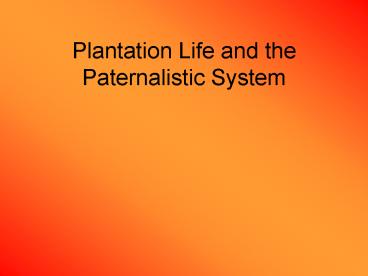Plantation Life and the Paternalistic System - PowerPoint PPT Presentation
1 / 13
Title:
Plantation Life and the Paternalistic System
Description:
The largest group of slave owners were the yeoman farmers who were ... was little if any genuine sympathy or understanding of black women by the white women. ... – PowerPoint PPT presentation
Number of Views:77
Avg rating:3.0/5.0
Title: Plantation Life and the Paternalistic System
1
Plantation Life and the Paternalistic System
2
Yeoman Farmer
- The largest group of slave owners were the yeoman
farmers who were moving from subsistence
agriculture to commercial production. - Most commonly they could not afford a large
number of slaves, so only had a few, and many
times left to work themselves. - The yeoman farmer was always economically
vulnerable, as a poor crop or a downturn in
cotton price would cause them to have to sell
their slaves. - Already wealthy middle-class had better
opportunity because of investment capital.
3
Planter Elite
- Two types of slave owning elite
- 1. Those that had inherited their wealth, very
few were self-made men - 2. Growing group as they expanded westward into
Alabama, Mississippi, and Louisiana called
nabobs, made up the Natchez.
4
The Natchez
- They consciously worked to establish and maintain
a lifestyle that was similar to the English
aristocracy. - Large plantations with spacious/elegant mansion,
and hospitable. - Men participated in hunting, politics, and
soldiering, and this led to acts of bravado such
as duels. - Women were expected to be gentle, charming, and
always welcoming. - Image was false slaves actually were what
maintained the wealth, and it was far from a
welcoming system. - Aimed to be like the yeoman farms
self-sufficient producing the food and clothing
for those there as well as the cash crop.
5
One of the ways Charleston attempted to control
its African American population was to require
all slaves to wear badges showing their
occupation. After 1848, free black people also
had to wear badges, which were decorated,
ironically, with a liberty cap. SOURCECourtesy
of the American Numismatic Society of New York.
6
Paternalistic South
- Slave owner who was the head of the household,
and his mistress who was his helpmate. - Everyone else on the plantation was a member of
the family and was to be regarded with humanity. - Included slave who like children were required to
do their work and do what they were told. - Slave owner and his wife spoke of slavery as a
burden and a duty. - Slave owners by extension expected not only
obedience, but gratitude from all the members of
their family.
7
Plantation Mistress
- The plantation mistress had a lot of
responsibility, but they carried little
authority. The master-slave relationship was an
illustration of their lives as well. - Spent most time tending to family (including
slaves) and supervising their performance. - The wife was always expected to be obedient and
respectful to her husband, because after-all, if
she wasnt why would the slaves be? - The women were also typically isolated from their
kin. Responsibilities dictated that they would
rarely leave husbands were much more likely to.
8
Slave Woman White Mistress Relationship
- Most slave women were forced to leave their
husband and child to serve the mistresses home. - While African-American Women took care of some of
the most intimate things (children) there was
little if any genuine sympathy or understanding
of black women by the white women. - When white women talked of the curse of slavery
most were speaking not of the evils of the
institution, but instead all of the extra work
that was expected of them. - Women known to be brutal in their treatment of
the slaves as well.
9
Violence and Coercion
- Most slaves were treated with great brutality.
Owners who killed their slaves were occasionally
brought to trial, (usually acquitted), but no
legal action was taken in cases of extreme abuse,
excessive punishment, and rape. - Rape was most common abuse of women slaves.
- Masters would rarely admit to fathering a child,
and there was nothing abused woman, or white
woman could do. - Abusive father passed traits to son.
- Only humanity that survived was due to
African-American community.
10
South Carolina Slavery Defense
- The lives and the existence of the whites and the
slaves were intertwined in the South. - William Henry Trescot stated, they were more
likely to secede from the Union than they were to
eliminate slavery.
11
This 1841 proslavery cartoon contrasts healthy,
well-cared-for African American slaves with
unemployed British factory workers living in
desperate poverty. The comparison between
contented southern slaves and miserable northern
wage slaves was frequently made by proslavery
advocates. SOURCELibrary of Congress.
12
Pro-Slavery Argument
- Looked to justify slavery it was in the Bible,
in Ancient Greece and Rome. - Best argument it was in the Constitution -
allowing slave importation for 20 years, the 3/5
Compromise, and a provision for the returning of
fugitive slaves. - Southerners saw the Denmark Vesy Conspiracy two
years later as a manifestation of the Northern
anti-slavery sentiment.
13
Southern Unity
- South began to pull together partially based on
blaming northern anti-slavery forces orYankee
peddlers and traders. - The Liberator debuted in 1831 by editor William
Lloyd Garrison. - British stopped all slavery in West Indies in
1834. - South Carolina began discussing secession.
- Tried to stop all anti-slavery ideas from
spreading - Illegal to teach slaves.
- Illegal to go to social gathering without a white
person present. - Gag rule no southern Congressman allowed to
discuss or debate slavery.































